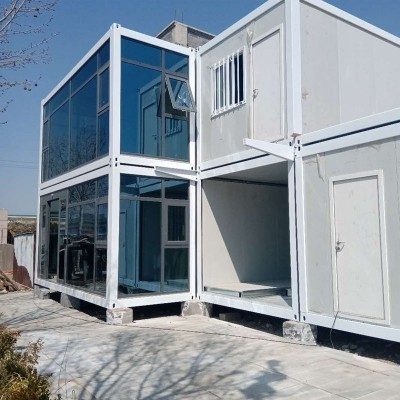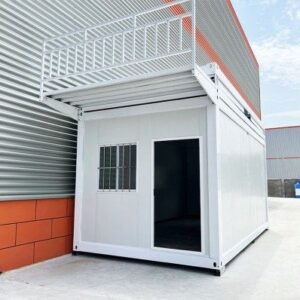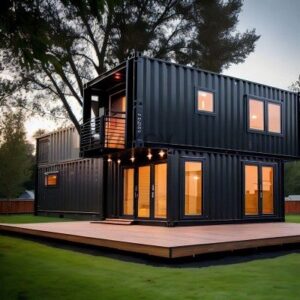What Are Shipping Container Homes
Shipping container homes are residential structures built by repurposing steel shipping containers commonly used for transporting goods worldwide. These modular units are transformed into livable spaces by modifying their interiors and exteriors to meet housing needs. Shipping container home design ideas have been gaining popularity due to their unique style, affordability, and sustainability.
Common Types and Sizes of Shipping Containers
Most shipping container homes use two standard container sizes:
| Container Size | Dimensions (L x W x H) | Common Uses |
|---|---|---|
| 20-foot | 20 ft x 8 ft x 8.5 ft | Small homes, studios, tiny houses |
| 40-foot | 40 ft x 8 ft x 8.5 ft | Larger homes, multi-room layouts |
High-cube containers, which are 1 foot taller (9.5 ft), offer more vertical space and are often preferred for residential uses.
Benefits of Shipping Container Homes
- Affordability: Containers are often less expensive than traditional building materials.
- Durability: Made of strong steel, containers withstand harsh weather and natural disasters.
- Speed of Construction: Modular nature allows quick assembly and easier transportation.
- Eco-Friendly: Repurposing containers reduces waste and the need for new building materials.
- Flexible Design: Easy to modify, stack, and combine multiple containers into custom layouts.
Drawbacks of Shipping Container Homes
- Insulation Challenges: Steel conducts heat and cold, requiring effective insulation to maintain comfort.
- Permitting Issues: Local zoning laws and building codes can restrict or complicate container home construction.
- Structural Modifications Needed: Cutting openings for windows, doors, and utilities weakens containers and requires reinforcement.
- Space Limitations: Narrow width and fixed dimensions impose design constraints.
- Corrosion Risks: Used containers may have rust or chemical residues needing thorough inspection and treatment before use.
Shipping container homes present a modern, sustainable approach to housing, but careful planning and preparation are essential to address their unique challenges. For more on container sizes and options, check 40-foot container house and 20-foot container house.
Planning Your Shipping Container Home
Before jumping into building a house out of shipping containers, planning is key. This stage sets the foundation for a smooth and successful container home project. Here’s what to focus on:
Assess Your Needs and Budget
Start by clearly defining what you want from your container home:
- Number of rooms and their purpose (bedrooms, kitchen, bathrooms, living space)
- Size requirements, keeping in mind container dimensions (usually 20 or 40 feet long)
- Lifestyle needs, like workspace, storage, or outdoor access
- Budget range — factor in container costs, modifications, labor, permits, and finishing
Being realistic about your budget upfront helps avoid surprises and keeps your project on track.
Choosing Containers and Layout Ideas
Choosing the right type and size of containers depends on your goals:
- Standard containers: 20 ft (160 sq ft) and 40 ft (320 sq ft) are most common
- High cube containers: Offer extra height for more interior space
- Consider single or multiple containers for an open floor plan or modular design
- Popular layouts include side-by-side containers or stacking vertically for multiple floors
Think about how your containers will fit on your land, and plan for easy access and transport.
Designing a Floor Plan Suitable for Shipping Container Dimensions
Since container homes use fixed-sized steel boxes, your floor plan must work within these dimensions:
- Plan rooms around width of 8 feet and lengths of 20 or 40 feet
- Use open floor concepts to maximize usable space
- Incorporate cut-outs for doors and windows early in your design
- Consider connecting containers with hallways or covered decks to increase living space
- Use software or work with a professional experienced in container home designs for best results
Local Zoning Laws and Building Codes to Check Before Starting
Shipping container homes face different regulations depending on location, so make sure to:
- Verify zoning laws to confirm container homes are allowed on your property
- Check building codes for structural, electrical, and plumbing standards
- Obtain necessary permits before construction begins to avoid legal issues
- Contact your city or county building department for specific requirements
- Be prepared to provide engineering plans showing modifications and reinforcements
Ignoring legal aspects can lead to fines or mandates to remove your home, so this step is crucial.
Preparing Containers for Construction
When you’re building a house out of shipping containers, getting quality containers is a crucial first step. You’ll need to decide between new or used containers, each with pros and cons:
- New containers are clean, corrosion-free, and structurally sound but cost more.
- Used containers are budget-friendly and often readily available but may have dents, rust, or previous chemical exposure.
Inspecting and Refurbishing Containers
Before you start cutting into the containers, inspect them thoroughly for any damage that could affect safety or durability:
- Check for rust spots and surface corrosion, especially around corners and seams.
- Look at the structural integrity—make sure there are no major dents or warping.
- If necessary, sandblast or treat rust areas to prevent further corrosion.
- Clean out any residues, especially on used containers to ensure they are safe and eco-friendly.
Cutting and Framing Openings for Doors Windows and Utilities
Modifying containers to become livable means cutting openings, but this requires care:
- Plan and mark out spots for doors, windows, and utility access based on your floor plan.
- Use proper metal-cutting tools to avoid weakening the container walls.
- After cutting, reinforce openings with steel framing or welding to maintain strength and structural safety.
- Frame out for windows and doors to allow secure installation that can withstand weather and use.
- Make sure utility paths for plumbing and electrical wiring are accounted for during this phase to avoid costly reworks later.
By preparing containers correctly, you set the foundation for a safe, durable shipping container home that meets your design and living needs.
Structural Modifications and Reinforcements for Shipping Container Homes
When building a house out of shipping containers, modifying the containers for structural safety is a critical step. Containers are strong as-is, designed to carry heavy loads stacked during shipping. But once you start cutting walls for doors, windows, or open living spaces, the original strength can weaken. Here’s how you handle these challenges:
Modifying Containers for Structural Safety
- Cutting openings: Any removal of metal must be reinforced. Use steel frames around large openings like windows and doors to maintain integrity.
- Preventing warping: Containers can twist or warp if sections are unsupported after cutting. Add cross-bracing or framing to keep the shape stable.
- Maintaining load paths: Keep the corners intact since they bear most of the structural load. Heavy modifications in corners require extra support.
Joining Multiple Containers Together
Most shipping container homes use more than one container to create enough living space. Joining them properly is essential:
- Welding vs bolting: Containers are typically welded to connect walls, floors, or roofs. Bolting can be used for easier adjustments but may require additional sealing.
- Aligning containers: Make sure containers are level and aligned to avoid gaps and structural stress. Site preparation and a solid base help this.
- Sealing joints: Use weatherproof sealants and flashing to prevent leaks where containers meet.
Steel Framing and Foundation Options
- Steel reinforcements: Adding a steel frame inside or around the containers strengthens the build, especially when joining multiple units or adding extra stories.
- Foundation choices: Containers need a strong, level foundation. Popular options include:
- Concrete slabs
- Pier footings
- Steel piles
- The foundation must support the container weight and resist moisture and soil movement.
By focusing on these structural modifications and reinforcements, your shipping container home can be safe, durable, and built to last while allowing you creative freedom on the design.
Insulating and Weatherproofing Your Shipping Container Home
Proper insulation and weatherproofing are essential for making a shipping container home comfortable and energy-efficient. Because containers are made of steel, they can easily get hot or cold without good insulation, and moisture can create condensation issues if not addressed.
Choosing the Right Insulation for Shipping Container Homes
Here are the most effective insulation options for container homes:
- Spray Foam InsulationProvides a tight seal against air and moisture. It expands to fill gaps, improving energy efficiency and controlling condensation. It’s a popular choice for shipping container homes because of its durability and insulation value.
- Blanket Insulation (Fiberglass or Mineral Wool)Easy to install and cost-effective. It fits inside wall framing but may require vapor barriers to prevent moisture problems.
- Rigid Foam Board InsulationGreat for walls and ceilings, offering high R-values with little thickness. It’s moisture-resistant and easy to work with.
Waterproofing and Preventing Condensation in Container Homes
Steel containers are prone to rust and condensation, especially in humid climates. To protect your home:
- Apply waterproof coatings or sealants on the exterior and areas where cuts have been made.
- Use vapor barriers on interior walls to reduce moisture buildup.
- Seal all seams and joints thoroughly to prevent water intrusion.
- Elevate your foundation or add drainage systems to avoid water pooling around or under your container.
Ventilation for Comfortable Living
Good airflow helps control moisture and keeps air fresh inside your container home. Consider:
- Installing mechanical ventilation systems like HRVs (Heat Recovery Ventilators) or ERVs (Energy Recovery Ventilators).
- Using operable windows and vents to promote natural cross-ventilation.
- Adding ceiling fans or exhaust fans in kitchens and bathrooms to reduce humidity.
Proper insulation, weatherproofing, and ventilation work together to keep your shipping container home comfortable year-round while protecting its structure.
Electrical Plumbing and Interior Finishing for Shipping Container Homes
When building a house out of shipping containers, running electrical wiring and installing plumbing are essential steps that must meet local safety codes and regulations. These systems need thoughtful planning to fit within the tight container walls without compromising structural integrity or living space.
Electrical Wiring in Container Homes
- Plan your electrical layout early to include outlets, lighting, and switches where you need them.
- Use metal conduit or armored cables to protect wiring inside the steel walls.
- Follow local electrical codes closely, which may require inspections and licensed electricians.
- Consider energy-efficient options like LED lighting and wiring designed to support solar power systems.
Plumbing Installation and Connections
- Plumbing must be carefully routed since containers have limited wall cavity depth.
- You can connect to municipal water and sewer lines if available or install a septic system on-site.
- Use PEX piping or similar flexible materials for easy installation and durability.
- Plan for proper drainage and venting to avoid moisture issues inside the container home.
Interior Wall Finishing Options
- Drywall is popular for a traditional home feel but requires framing and moisture barriers to prevent rust.
- Wood paneling or plywood can add warmth and is easier to install on container walls.
- Other materials like metal panels or composite boards can offer durability and industrial aesthetics.
- Adding insulation before wall finishing is critical to maintain comfort and energy efficiency.
Flooring and Ceiling Choices
- Flooring options depend on your style and budget. Common choices:
- Vinyl or laminate floors for durability and moisture resistance.
- Engineered wood flooring for a natural look and easier installation.
- Concrete floors can be polished for a modern, industrial finish but may need rugs for comfort.
- For ceilings, you can install drywall, wood planks, or metal panels based on your design goals.
Properly handling these systems ensures your shipping container home is safe, functional, and comfortable—matching or even exceeding traditional build standards.

Heating Cooling and Energy Efficiency for Shipping Container Homes
When it comes to heating and cooling your shipping container home, you need solutions that fit the unique tight space and metal construction. Containers can heat up quickly in summer and get cold in winter, so planning an efficient HVAC system is key.
HVAC Options Tailored to Container Homes
- Mini-split systems are popular because they’re compact, energy-efficient, and don’t require ductwork—perfect for container homes’ tight layouts.
- Portable heaters and window AC units can work for small spaces or temporary setups but aren’t ideal for larger or permanent homes.
- Heat pumps offer both heating and cooling and can be very efficient if your climate allows it.
- Proper ventilation is critical to avoid moisture buildup, mold, and stale air inside metal walls.
Utilizing Solar Panels and Sustainable Energy Solutions
Making your container home energy-efficient goes hand in hand with integrating solar panels and renewable energy systems. Many owners choose:
- Rooftop solar panels to generate electricity, reduce utility bills, and power HVAC systems.
- Battery storage systems to store energy for use during cloudy days or nighttime.
- Energy-efficient appliances and LED lighting to further cut power use.
- Installing solar water heaters or heat pumps can also reduce reliance on fossil fuels.
Tips for Improving Energy Performance
- Insulate well to reduce heating and cooling loads—spray foam insulation is highly effective.
- Use reflective roof coatings to limit heat absorption.
- Incorporate smart thermostats to control your heating and cooling efficiently.
By combining the right HVAC setup with sustainable energy options, your shipping container home can stay comfortable year-round while keeping energy costs down.
Cost Estimate and Budgeting for Shipping Container Homes
Building a house from shipping containers involves several costs beyond just buying the containers. Understanding these expenses upfront helps you plan better and avoid surprises.
Typical Costs Involved in Shipping Container Home Construction
- Containers: New containers typically cost $3,000 to $6,000 each depending on size and condition. Used containers are cheaper, often $1,500 to $3,000, but may need extra repairs.
- Modifications: Cutting, welding, and reinforcing openings for doors, windows, and utilities usually run between $1,000 to $5,000 per container, depending on complexity.
- Labor: Skilled labor for structural work, welding, and finishing varies by location but budget around $30 to $60 per hour. Overall, labor can be 30-50% of your total project cost.
- Insulation and Weatherproofing: Proper insulation (spray foam or blanket) and waterproofing materials generally cost $3,000 to $8,000 for a typical container home.
- Electrical and Plumbing: Installing wiring, plumbing, fixtures, and hookups connects your home to utilities and usually costs between $5,000 and $15,000 depending on local codes and size.
- Interior Finishing: Drywall, flooring, cabinetry, and fixtures add up to $7,000 to $20,000 depending on materials and style.
- Foundation and Site Prep: Delivering containers and preparing the land (foundation, grading) often costs $5,000 to $15,000.
- Permits and Inspections: Budget for local building permits and inspections; expect around $1,000 to $3,000, varying by jurisdiction.
Cost Saving Tips for Building a Shipping Container Home
- Choose used containers wisely to save money but ensure they’re structurally sound and free of harmful chemicals.
- Keep modifications minimal by using container dimensions creatively to reduce cutting and welding.
- Opt for modular designs that stack or line containers efficiently to reduce foundation and framing costs.
- DIY where possible, especially on interior finishing and simple plumbing or electrical work if local codes allow.
- Use cost-effective insulation like rigid foam panels combined with vapor barriers to get good performance without overspending.
- Plan ahead for permits to avoid delays and fines that add extra cost.
- Shop local contractors who understand container homes to get better pricing and faster turnaround.
By breaking down your budget into these key areas and sticking to smart choices, building a shipping container home becomes a more predictable and manageable investment tailored to your needs in the U.S. market.
Legal Considerations and Permits for Shipping Container Homes
Building a shipping container home in the United States means dealing with more than just construction—you’ll need to navigate permits, inspections, and local regulations to stay legal and avoid costly delays.
Navigating Permits and Inspections
Before you start construction, check your local building department for specific requirements related to container homes. Here’s what to expect:
- Building Permits: Required for almost all residential construction, including container homes. You’ll need to submit detailed plans showing structural modifications, electrical, and plumbing work.
- Inspections: After permits are issued, expect multiple inspections during the building process—foundation, framing, electrical, plumbing, and final occupancy inspection.
- Energy Codes: Many areas require compliance with energy efficiency codes, so your insulation, ventilation, and HVAC plans must meet these standards.
Dealing with Zoning Boards
Zoning laws vary widely across cities and counties, affecting where you can place a shipping container home:
- Zoning Restrictions: Some zones don’t allow container homes or restrict their size and appearance. Research if container homes are allowed in your area.
- Setbacks and Height Limits: Containers have fixed dimensions. You’ll need to follow setback rules (how far your home is from property lines) and height restrictions for your container configuration.
- Use Variance: If your land isn’t zoned for container homes, you might apply for a variance or special use permit, but this process can be lengthy and uncertain.
Working with Homeowner Associations
If your property is under an HOA, expect additional hurdles:
- HOA Rules and Covenants: Many HOAs have strict standards on home appearance, materials, and modifications. Verify if containers are allowed or meet their aesthetic requirements.
- Approval Processes: You may need to get design approval before building. Failure to do so can lead to fines or forced removal.
- Negotiation: Sometimes presenting detailed plans and samples helps persuade the HOA to accept container homes as sustainable and modern housing options.
Key Tips for Legal Success
- Start permitting research early—requirements differ widely across states and municipalities.
- Work with architects or builders familiar with shipping container home permits and regulations in your region.
- Keep detailed records of all permits and inspections.
- Be prepared for added costs and timelines related to legal compliance.
Understanding and managing the legal landscape of container home construction is as critical as the build itself. Proper permits and approvals protect your investment and secure your right to live comfortably in your shipping container home.
Case Studies and Inspiration for Shipping Container Homes
Looking for real-world examples of shipping container homes can spark great ideas for your own build. Container homes come in many styles—from minimalist tiny houses to multi-container luxury residences. Seeing how others have designed and transformed their shipping containers helps visualize your possibilities and avoid common pitfalls.
Beautifully Designed Container Homes to Inspire You
Here are some standout types of container homes you might want to draw inspiration from:
- Modern Minimalist Designs: Clean lines and open spaces make the most of the confined container footprint. Often feature floor-to-ceiling windows and clever storage solutions to keep spaces open and bright.
- Multi-Container Layouts: Joining 2 or more containers can create spacious living areas, separate bedrooms, or studios. These builds often use steel reinforcements and creative floor plans tailored to container dimensions.
- Eco-Friendly and Sustainable Homes: Using reclaimed containers combined with solar panels and rainwater harvesting, many projects aim for net-zero energy use.
- Luxury Container Homes: High-end finishes, custom cabinetry, and smart home technology turn containers into comfortable, upscale dwellings.
Before and After Photos Show Practical Transformation
Visuals of container homes before and after renovations highlight the real work involved:
- From rusty shells to cozy interiors, you’ll see how prepping, insulating, and finishing transform cold metal boxes into warm homes.
- Structural modifications for doors, windows, and open-plan living add light and ventilation.
- Interior finishes like wood paneling, drywall, and flooring make huge differences in comfort and style.
Design Tips Based on Case Study Insights
- Plan your layout closely around the container’s size; typical 20- or 40-foot containers create long, narrow spaces.
- Use modular container homes strategies to expand and customize, adding more containers or expandable units.
- Focus on insulation and ventilation early to avoid moisture problems that many beginners face.
- Check out specialized container home products and layouts that simplify building, such as 20-foot container house layouts or expandable container houses.
Exploring these case studies not only offers aesthetic ideas but also practical lessons in the challenges and smart solutions that come with shipping container home construction. Whether aiming for a tiny home or a spacious dwelling, seeing how others have done it can help guide your build to success



